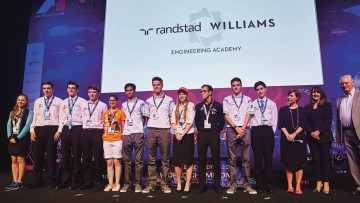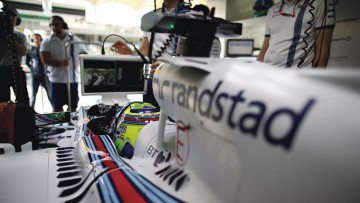What do sponsors get from Formula 1? Most fans think the answer is pretty short. Sponsors get a logo on the car, plus a few tickets for guests, a marketing hook and that’s about it.
In fact, the relationship between teams and sponsors can run deep. In the case of Williams Martini Racing and Randstad it’s a technical partnership which covers everything from knowledge-sharing to developing the next generation of global engineering talent. The logo on the car is merely a symbol of a successful relationship.
The relationship began because of our mutual need to understand the future of engineering and IT
Randstad is a great example of how sponsorship really works. Randstad is a world-leading HR services provider, founded in the Netherlands in 1960. It finds jobs for all sorts of workers, from temporary labourers through to senior management at the world’s biggest companies. The partnership with Williams began ten years ago, during which time Randstad has repeatedly extended and expanded the deal. It’s been a huge success for both parties.
“The relationship began because of our mutual need to understand the future of engineering and IT,” says Randstad director international marketing Joost Schriever. “We are one of the world’s biggest recruiters in engineering and IT. It is vital that we understand what technologies and skills are going to be needed in the future. Formula 1 gives us that insight.”
Fans of the sport will give you chapter and verse on racing technologies which have later filtered down to the mainstream. Carbon brakes, sequential gearboxes, hybrid powertrains and traction control began in Formula 1. Today they are commonplace in road cars.
 Furthermore, the fine tuning methodologies used by the teams is a decade ahead of anywhere else. Look at the aerodynamic computer simulations or the use of industrial 3D printing to manufacture futuristic components. Being a partner keeps Randstad immersed in the innovations which will be shaping engineering and IT in the years to come.
Furthermore, the fine tuning methodologies used by the teams is a decade ahead of anywhere else. Look at the aerodynamic computer simulations or the use of industrial 3D printing to manufacture futuristic components. Being a partner keeps Randstad immersed in the innovations which will be shaping engineering and IT in the years to come.
“It’s vital we know these things,” says Mr Schriever. “It means we can give informed advice to our clients and candidates. That elevated knowledge puts us above our rivals.”
There is a pay-off in terms of corporate culture. The electrifying energy of the sport is the stuff of legend. It lifts and inspires everyone involved. “We love that we have shared values,” says Mr Schriever. “Employees at Williams and Randstad have the core goal of striving for perfection. They need the best drivers, the top engineers, peak strategy and a great team to win.
“At Randstad we work to get the best candidates, the top talent and the optimum recruitment strategy for our clients so they can achieve their ambitions. Get it right and magic happens. The F1 connection is a way for us to communicate this mindset throughout our organisation, not only in the UK but all over the world.”
Above all, the partnership offers a radical way to deal with the biggest problem in the STEM (science, technology, engineering and maths) sector, namely how to encourage new talent to enter. The UK alone has a shortfall of 40,000 science and technology graduates a year, according to the government. A Department for Business, Innovation & Skills survey revealed only 15 per cent of British children would consider a career in engineering, with 40 per cent calling it “dirty” and half calling it “boring”.
The problem is so severe the F1 teams are worried it will affect their ability to innovate. “I think that engineering has a very poor image in the UK,” says Pat Symonds, Williams chief technical officer. “That isn’t helped by the fact that when you book someone to come and mend your washing machine, they call themselves an engineer.”
To address the issue, Randstad and Williams created an elite institution. The Randstad Williams Engineering Academy is designed to identify talented young engineers from around the world and provide them with advice, mentoring and guidance to secure a job in Formula 1 or the career path of their choice. The curriculum focuses on e-learning through a web portal. Students must submit an annual essay-based project. And throughout the experience they are mentored and tutored by the engineers at Williams.
 Mr Symonds says he believes the experience can have a real impact on the lives of the students enrolled. “I think at Williams we have recognised there are some very good graduates coming out of university these days who are very specialised and very on top of their subjects, but sometimes lacking the overview some of us older engineers have gained over the years,” he says.
Mr Symonds says he believes the experience can have a real impact on the lives of the students enrolled. “I think at Williams we have recognised there are some very good graduates coming out of university these days who are very specialised and very on top of their subjects, but sometimes lacking the overview some of us older engineers have gained over the years,” he says.
“These days it gets more difficult for students to get that overview. So we decided to target students who have those elements of leadership and cross-functional engineering, who in themselves could motivate others – essentially looking for the students who will become top F1 engineers in the future.”
Entrants come from all over the world, including Portugal, Bahrain, Australia, United States and UK.
The experts at Williams adore the Academy. Mr Symonds says: “It is a real joy to see employees, who not that many years ago were students themselves, putting so much work into helping their younger colleagues and thoroughly enjoying the experience. It gives me a lot of pleasure.”
And the good work extends far beyond the small number of lucky individuals participating. Students globally will be inspired to see engineering in a new light, one that reflects the high-tech nature of the job, which is as advanced, challenging and rewarding as anything in financial services or coding, for example.
“The Academy shows what Formula 1 can achieve,” says Randstad’s Mr Schriever. “Our partnership has the power to change perceptions across the world and inspire a new generation. That is why we get so excited about our involvement with the sport.”
It may also get a few fans to think again about the role sponsors play in the sport. The logo on the car? It really is just the start.


